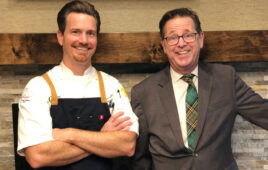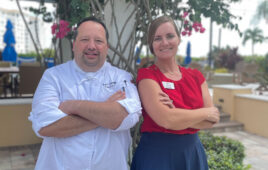Club chefs are searching for the best ways to safely provide employee meals.

When it comes to serving staff meals, the COVID-19 pandemic has forced club and resort chefs to get creative in order to keep their staffs well-fed.

Executive Chef Tim Recher, CEC, AAC, CWX of Quail West Golf and Country Club in Naples, Fla.
“Whether it’s our employees eating in the cafeteria or our members and guests sitting in the dining room, we don’t want anyone to not have a great meal,” says Executive Chef Tim Recher, CEC, AAC, CWX of Quail West Golf and Country Club in Naples, Fla.
In the initial months of shutdowns, Executive Chef James Patterson of Sedgefield Country Club in Greensboro, N.C., didn’t have very many staff members to feed, because only a few were working. So he handled staff meals on a made-to-order basis.
Now that most clubs are up and running again, however, bartenders, servers, housekeepers and other staff members are working consistently, and the number of meals being provided to them is increasing.
As chefs seek better ways to offer staff meals to larger groups, finding a solution to follow proper social distancing while doing so has involved a lot of brainstorming, and is still a changing process. “We’re all in the same boat here,” says Recher.
At Boca Grove Golf and Tennis Club in Boca Raton, Fla., the staff used to have access to a hot and cold buffet inside the staff lounge, and Executive Chef Dominick Laudia offered five to six hot meal options, a salad bar and dessert for staff members to enjoy.
Once COVID began, however, Boca Grove stopped using a self-service buffet and transitioned to individually packaged meals for staff to pick up and eat in their department areas.
That’s proving to be one of the two most common tactics club chefs are now employing, along with still providing a buffet, but staffing it with one person who portions and plates each meal for the staff members.
At Sedgefield CC, Patterson put his Executive Sous Chef in charge of staff meals, a task that also involves portioning everything and wrapping and keeping every meal separate from others.

Executive Chef James Patterson of Sedgefield Country Club in Greensboro, N.C.
Sedgefield tries to rotate through a variety of food options that might include Asian, Southwest or Hispanic cuisine, but this can be challenging. The meals usually involve a protein, starch and vegetable. Wraps, sandwiches and salads are also available for staff to grab.
Pros and Cons
No matter how chefs now choose to prepare staff meals, there are positive and negative considerations. The amount of food waste is decreasing because everything is being individually portioned. The individual meals also help to make it easier to accommodate dietary restrictions and accommodate staff preferences.
But while the individually prepared meals do provide a safe, socially distanced way to serve meals, they come at a cost. At Boca Grove, Laudia says, the club’s spending for packaging is increasing, because of the large amounts of to-go boxes being used for hundreds of meals now being prepared not only for the staff, but club members as well. This can also lead to additional paper waste.
“We were more concerned with keeping our staff safe, so we made the decision that putting the meals in to-go containers would be the best option for us,” says Laudia.
Another challenge is simply the extra amount of effort and time it takes to prepare the meals. Rather than preparing large pans of food and leaving them on a buffet line, packaging meals individually is much more labor-intensive.

Executive Chef Dominick Laudia of Boca Grove Golf and Tennis Club in Boca Raton, Fla.
Laudia and Patterson plan to continue providing staff meals by packaging everything individually, but Recher is looking for a better way to meet his staff’s needs. “Doing individually boxed meals really isn’t efficient and feasible,” he says. So he is considering a switch to a served buffet process, although that presents the problem of finding enough seating for everyone to eat in their own department areas while being properly social distanced.
One option for addressing that is to utilize banquet spaces that aren’t being used currently, as well as other dining rooms, to help spread out staff during their meal times.
“It’s still very fluent and everybody is trying to figure it out,” says Recher. “There is not a perfect answer right now, unfortunately.”




